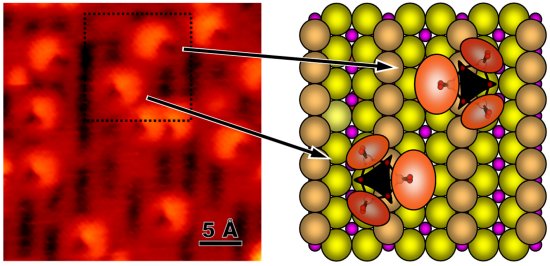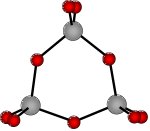博文
美科学家研究金属氧化物催化剂取得新进展(旧闻回顾)
|
这个体系中,三氧化钨循环的团簇分子挨分子地在二氧化钛基底上排列着。每个团簇都有一个钨原子略为突起,提供催化反应的作用。这个发现,为在把碳氢化合物转化为燃料及副产品反应中,金属氧化物起的催化剂作用的理论研究,建立了一个基础平台。
德州大学教授、PNNL界面催化研究所所长Mike White说,这个典型体系与商用催化剂有很大的不同。商用催化剂成分和体积的可变性, 使很难在分子尺度难精确地理解和描述所发生的反应。商用催化剂像砂砾堆,有各种大小的石头。一些石头是紫色的,而一些是蓝色的。一些起这种作用,一些起另 一种作用。但是,我们的新典型体系的所有石头都是同样大小的。
White教授说,在新体系中,制造出了最小尺度的统一大小的纳米簇,而且钨是在其正常的氧化态的。在理论上,你会拥有所有建立化学键和破坏化学键所需要的东西,这在科学上是个很大突破。
White还说,尽管看起来简单,但是这个典范体系的制造是很有挑战的。他的合作者们使用PNNL的许多特殊仪器来制备基底和团簇。他们使用 特殊的方法把氧化钨由固体直接变成气态,然后再把三氧化钨的分子环固定在氧化钛的基底上。制成后他们使用扫描电镜对体系表面成了像,并使用x射线谱仪分析 了钨的氧化状态。
White教授最后说,这个基础科学的发现将使我们在未来更好地控制能源的化学转换。
New Model System Offers Fundamental Insight into Catalyst Structure and Behavior
Like tiny nano-soldiers on parade, the cyclic tungsten trioxide clusters line up molecule-by-molecule on the titanium dioxide platform. One tungsten atom from each cluster is raised slightly, holding forth the potential to execute catalytic reactions. The new model system of nano-structures offers chemists a view into the structure and reaction mechanisms of metal oxides.
Developed by researchers from the U.S. Department of Energy's Pacific Northwest National Laboratory, the University of Texas - Austin, and Washington State University, formation of the model system was reported in the June 23 online issue of Angewandte Chemie, International Edition. Their discovery may offer a platform for fundamental reactivity studies of metal oxides used as catalysts in converting hydrocarbons into fuels and value-added chemicals.
There is a striking difference between commercial catalysts and the new model system. Variability in commercial catalyst size and chemical composition makes it difficult to accurately understand or describe the reactions taking place at a molecular level. Mike White, the UT professor leading the PNNL Institute for Interfacial Catalysis said, "Commercial catalysts are like a gravel pile with many sizes of rocks. Some rocks are purple. Some are blue. Some do one thing; some do another. But, our system has all the same size rocks."
The model system—where all the molecular clusters are the same size, are evenly dispersed, and are oriented in one of two directions on a single layer of titanium oxide crystals—holds promise as a platform for studying the behavior of early transition metal oxides. White continued, "While we have created the smallest nano-cluster of a uniform size you can imagine, it is a real oxide; the tungsten is in its normal oxide state. In principle, you have all the things needed to make bonds and break bonds. That's the scientific breakthrough here."
Though it appears simple, the model system was very challenging to develop. The collaborators employed specialized equipment available from the Environmental Molecular Sciences Laboratory, a DOE user facility located at PNNL, to prepare and characterize the platform as well as the clusters. Using a unique approach that changed the tungsten oxide directly from a solid to a gas, the collaborators successfully stabilized the molecular rings—or "trimers"—of tungsten on the titanium platform.
A scanning tunneling microscope imaged not only the trimers but also their consistent alignment with the single crystal structure of the platform. "A scanning tunneling microscope must be very stable; you have to vibrationally isolate the instrument. It cannot move even a small amount because we are using a stream of electrons to measure the distance from the microscope's tip to a small space between atoms," White explained. In addition to scanning tunneling microscopy, the collaborators characterized the cluster mass, determined the stoichiometry, and identified the tungsten oxidation state using X-ray photoelectron spectroscopy.
"This is a small piece of the basic science that could lead to control of chemical transformations for our energy future," White concluded. For the first time, researchers have created and imaged monodisperse oxide clusters on another oxide.
Work to develop the model system is part of the Early Transition Metals as Catalysts project at PNNL and was supported by the U.S. Department of Energy's Office of Basic Energy Sciences, Chemical & Materials Sciences, Geosciences, and Biosciences Division.

Oleksandr Bondarchuk, Xin Huang, Jooho Kim, Bruce D. Kay, Lai-Sheng Wang, J. M. White, and Zdenek Dohnálek. July 17, 2006. "Formation of Monodisperse (WO3)3 Clusters on TiO2(110)." Angewandte Chemie International Edition 45(29):4786-4789.
A pproximately 5.3 angstroms in width, the tungsten trioxide trimers exhibit a very stable chemical structure that, with further research, may provide an ideal platform for fundamental studies of catalytic reactions commonly used in fuels and value-added chemical production
全文下载浏览
全文https://wap.sciencenet.cn/blog-3913-9016.html
上一篇:科学家合成出一种新型膜能够又快又好地分离天然气中的CO2
下一篇:科学家首次提出采用均相催化剂连续合成中链醛类的方法—溶解催化剂、CO2超临界萃取



